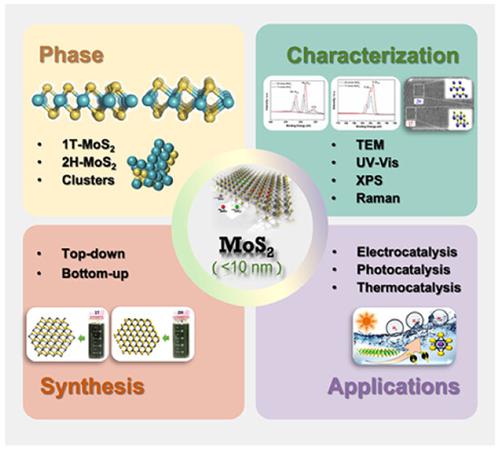当前位置:
X-MOL 学术
›
Carbon Energy
›
论文详情
Our official English website, www.x-mol.net, welcomes your feedback! (Note: you will need to create a separate account there.)
A review on ultra-small undoped MoS2 as advanced catalysts for renewable fuel production
Carbon Energy ( IF 20.5 ) Pub Date : 2024-02-27 , DOI: 10.1002/cey2.521 Guoping Liu 1 , Lingling Ding 2 , Yuxuan Meng 1 , Ahmad Ali 1 , Guifu Zuo 1 , Xianguang Meng 1 , Kun Chang 2 , Oi Lun Li 3 , Jinhua Ye 4
Carbon Energy ( IF 20.5 ) Pub Date : 2024-02-27 , DOI: 10.1002/cey2.521 Guoping Liu 1 , Lingling Ding 2 , Yuxuan Meng 1 , Ahmad Ali 1 , Guifu Zuo 1 , Xianguang Meng 1 , Kun Chang 2 , Oi Lun Li 3 , Jinhua Ye 4
Affiliation

|
Molybdenum disulfide (MoS2) has garnered significant attention in the field of catalysis due to the high density of active sites in its unique two-dimensional (2D) structure, which could be developed into numerous high-performance catalysts. The synthesis of ultra-small MoS2 particles (<10 nm) is highly desired in various experimental studies. The ultra-small structure could often lead to a distinct S–Mo coordination state and nonstoichiometric composition in MoSx, minimizing in-plane active sites of the 2D structure and making it probable to regulate the atomic and electronic structure of its intrinsic active sites on a large extent, especially in MoSx clusters. This article summarizes the recent progress of catalysis over ultra-small undoped MoS2 particles for renewable fuel production. Through a systematic review of their synthesis, structural, and spectral characteristics, as well as the relationship between their catalytic performance and inherent defects, we aim to provide insights into catalysis over this matrix that may potentially enable advancement in the development of high-performance MoS2-based catalysts for sustainable energy generation in the future.
中文翻译:

超小型未掺杂MoS2作为可再生燃料生产先进催化剂的综述
二硫化钼(MoS 2)因其独特的二维(2D)结构中的高密度活性位点而在催化领域引起了广泛关注,可开发成多种高性能催化剂。在各种实验研究中非常需要合成超小 MoS 2颗粒(<10 nm)。超小结构通常可以在MoS x中产生独特的S-Mo配位态和非化学计量组成,从而最大限度地减少二维结构的面内活性位点,并使其有可能调节其内在活性位点的原子和电子结构。很大程度上,特别是在 MoS x团簇中。本文总结了超小未掺杂MoS 2颗粒催化可再生燃料生产的最新进展。通过系统地回顾它们的合成、结构和光谱特征,以及它们的催化性能和固有缺陷之间的关系,我们的目标是提供对该基质的催化作用的见解,这可能有助于推动高性能MoS2的开发用于未来可持续能源生产的2基催化剂。
更新日期:2024-03-02
中文翻译:

超小型未掺杂MoS2作为可再生燃料生产先进催化剂的综述
二硫化钼(MoS 2)因其独特的二维(2D)结构中的高密度活性位点而在催化领域引起了广泛关注,可开发成多种高性能催化剂。在各种实验研究中非常需要合成超小 MoS 2颗粒(<10 nm)。超小结构通常可以在MoS x中产生独特的S-Mo配位态和非化学计量组成,从而最大限度地减少二维结构的面内活性位点,并使其有可能调节其内在活性位点的原子和电子结构。很大程度上,特别是在 MoS x团簇中。本文总结了超小未掺杂MoS 2颗粒催化可再生燃料生产的最新进展。通过系统地回顾它们的合成、结构和光谱特征,以及它们的催化性能和固有缺陷之间的关系,我们的目标是提供对该基质的催化作用的见解,这可能有助于推动高性能MoS2的开发用于未来可持续能源生产的2基催化剂。



























 京公网安备 11010802027423号
京公网安备 11010802027423号